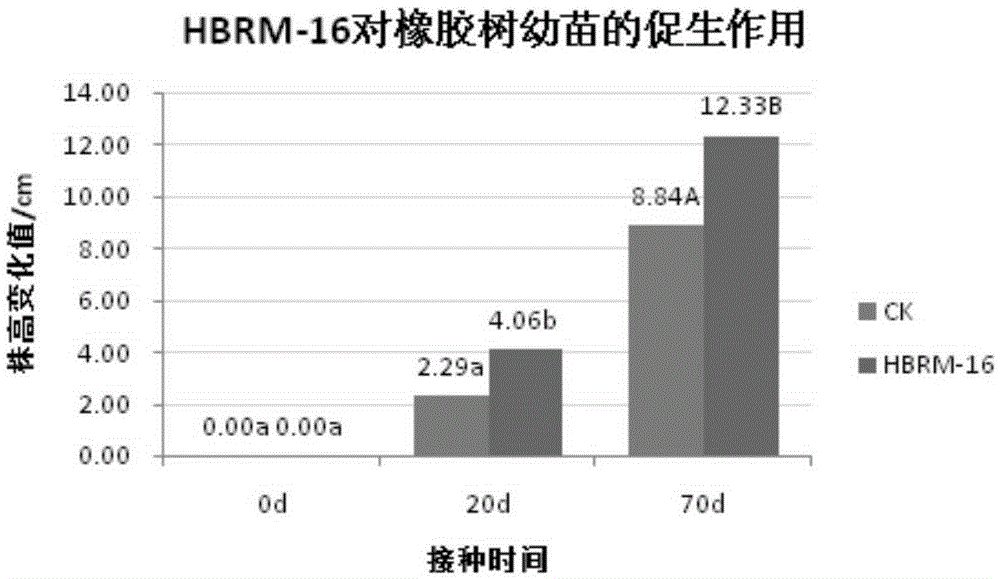Bacterial strain HBRM-16 capable of promoting growth of roots of rubber tree and application of bacterial strain HBRM-16
A HBRM-16, rubber tree technology, applied in the field of plant microorganisms, can solve the problems of natural rubber production constraints and other issues
- Summary
- Abstract
- Description
- Claims
- Application Information
AI Technical Summary
Problems solved by technology
Method used
Image
Examples
Embodiment 1
[0029] Example 1 Isolation and purification of strain HBRM-16 and its ACC deaminase activity assay
[0030] 1.1 Sampling
[0031] The sample is the rhizosphere soil of rubber trees in Guangba Farm, Dongfang City, Hainan Province. When sampling, avoid roadsides and fertilization ditches, and select forest segments with no obvious environmental impact (including water pollution and human impact) for distribution according to the diagonal method. Put the rubber tree fine roots with the rhizosphere soil collected into a plastic bag and make a record.
[0032] 1.2 Isolation and purification of strains
[0033] 1.2.1 Sample processing
[0034] Take 5 sections of roots with a size of about 1 cm and put them into 50 mL of sterile water, soak them for 10 min, shake them slightly for 5 min, and make a suspension for later use.
[0035] 1.2.2 Isolation and purification of strains
[0036] Take 1mL of the suspension and add it to 50mL of PAF culture medium, shake it at 28°C and 200r / min...
Embodiment 2
[0047] Identification of embodiment 2 bacterial strain HBRM-16
[0048] 1. Microbiological characteristics
[0049] Observe the morphological characteristics of the HBRM-16 strain cultured in a 28°C incubator, as shown in figure 1 As shown, the HBRM-16 strain was found to be short-spherical brevibacteria, Gram-stained negative, with perinatal flagella, motility, no capsule, and no spores; after culturing on TSB medium for 48 hours, the colonies were nearly round, opaque and bordered Neat, producing red water-soluble pigment, the middle red is darker and the edge is lighter, the surface is smooth, the texture is sticky, easy to pick, the average diameter of the colony is 8.90mm, and the average diameter of 24h is 6.80mm.
[0050] 2. Molecular biological identification
[0051] Using the total DNA of the strain as a template, the general primer 27F (5'-AGAGTTTGATCCTGGCTCAG-3') and the reverse primer 1492R (5'-ACGGCTACCTTGTTACGACTT-3') were used to amplify 16S rDNA. The primer...
Embodiment 4
[0095] The formulation of embodiment 4 growth curve
[0096] Cultivate the strain in TSB medium overnight (10-12h), inoculate it into sterile medium according to the inoculum size of 1%, and after mixing evenly, take 5mL of the mixed solution into sterile test tubes marked with time, at the optimum Shake culture at growth temperature (200r / min), select a total of 17 time points from 0 to 50h for timing sampling and measurement, use uninoculated liquid medium as blank control, and select 600nm wavelength for colorimetric measurement. The culture solution with high cell density is properly diluted with liquid medium and then measured so that its OD600 is within 0.1-0.65 (before measuring the OD value, shake the culture solution to be measured to make the cells evenly distributed).
[0097] Taking time as the abscissa and OD600 as the ordinate, draw the growth curve of the bacteria, see figure 2 .
[0098] From the growth curve of the strain HBRM-16, it can be seen that the la...
PUM
| Property | Measurement | Unit |
|---|---|---|
| The average diameter | aaaaa | aaaaa |
| The average diameter | aaaaa | aaaaa |
| Caliber | aaaaa | aaaaa |
Abstract
Description
Claims
Application Information
 Login to View More
Login to View More - R&D
- Intellectual Property
- Life Sciences
- Materials
- Tech Scout
- Unparalleled Data Quality
- Higher Quality Content
- 60% Fewer Hallucinations
Browse by: Latest US Patents, China's latest patents, Technical Efficacy Thesaurus, Application Domain, Technology Topic, Popular Technical Reports.
© 2025 PatSnap. All rights reserved.Legal|Privacy policy|Modern Slavery Act Transparency Statement|Sitemap|About US| Contact US: help@patsnap.com



